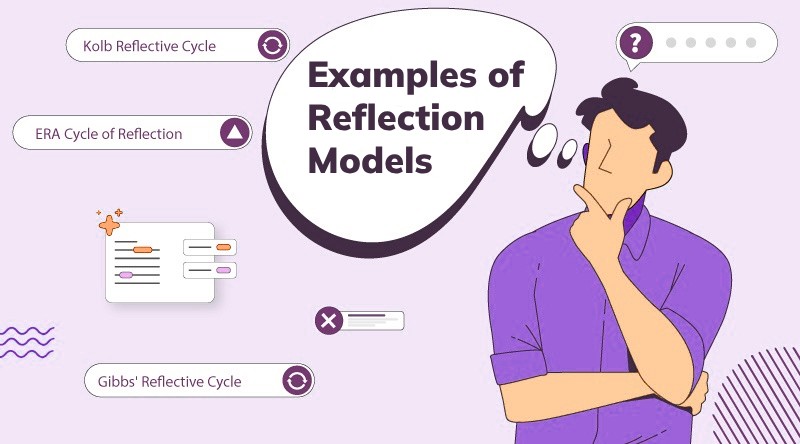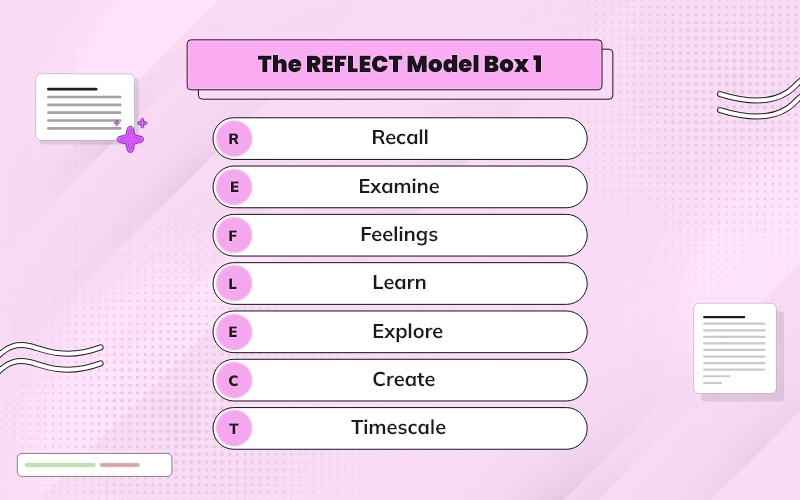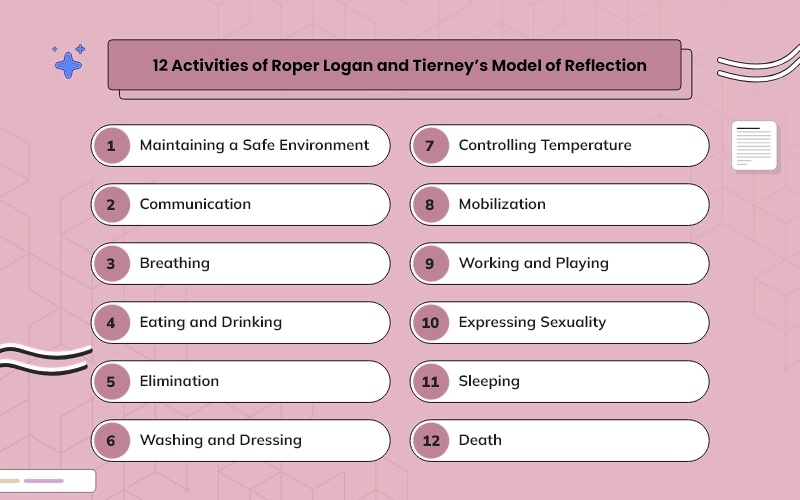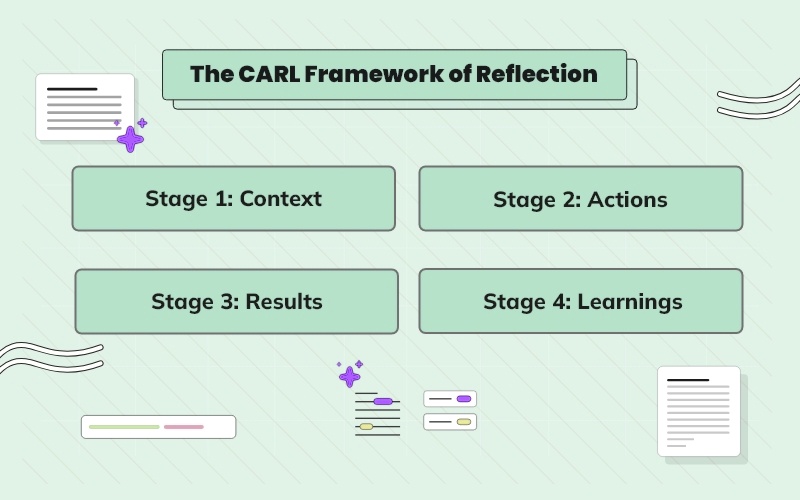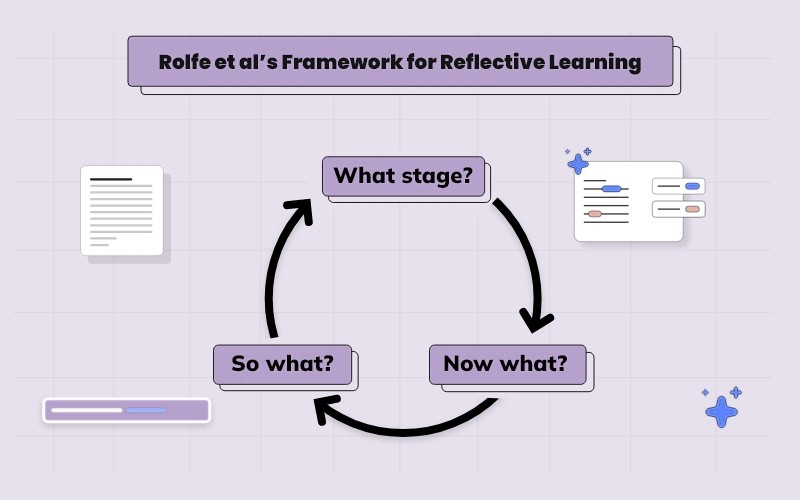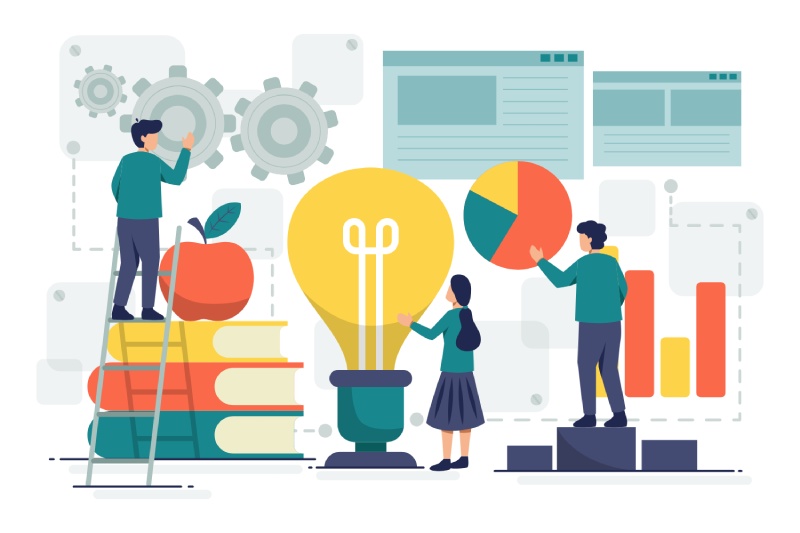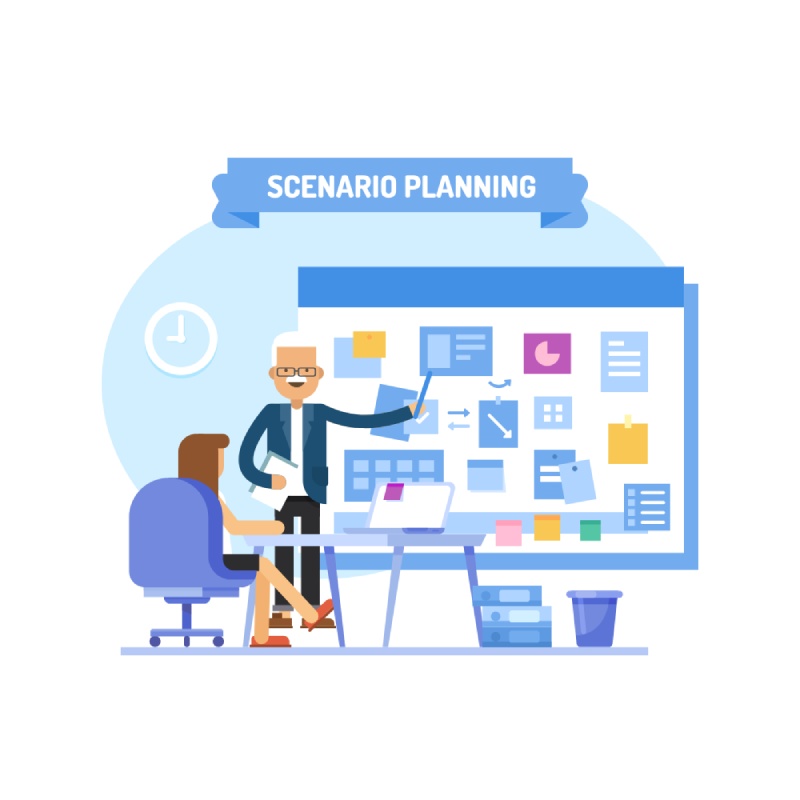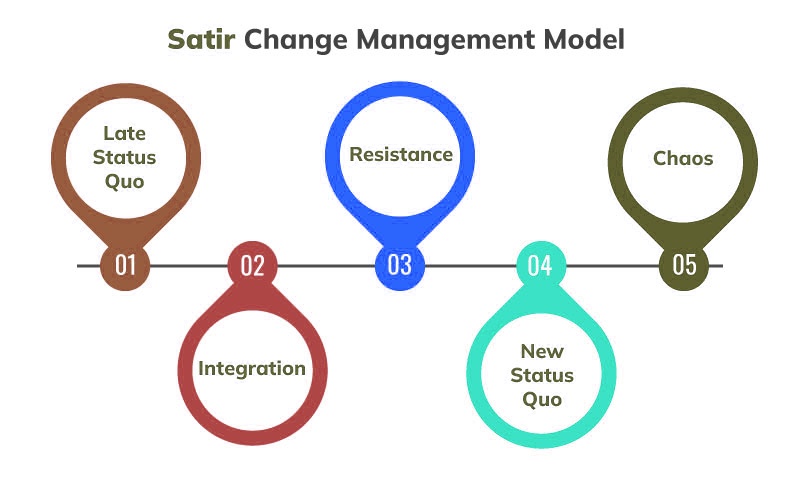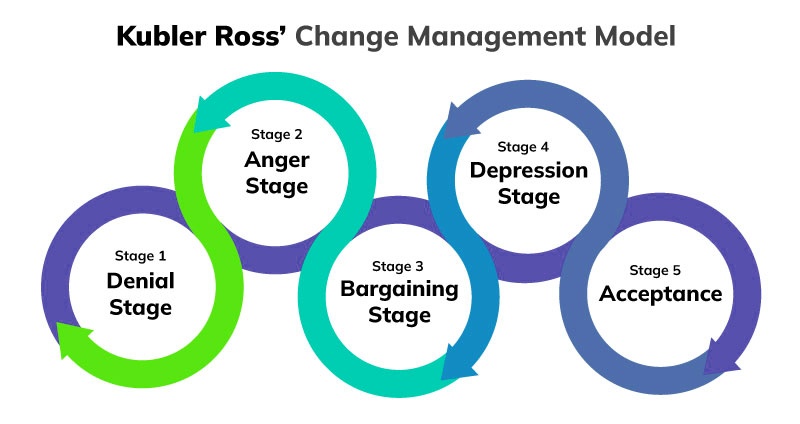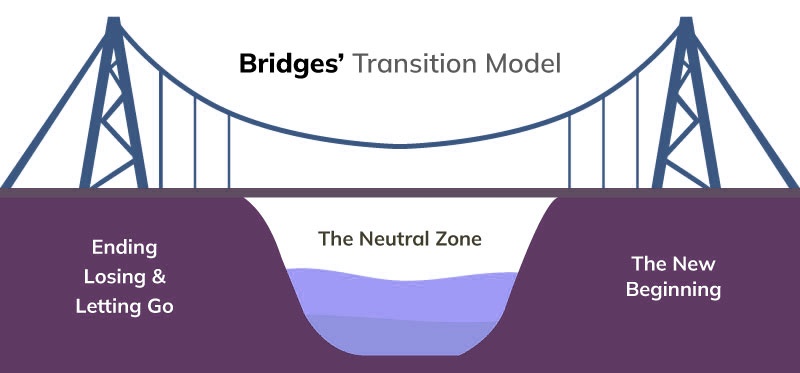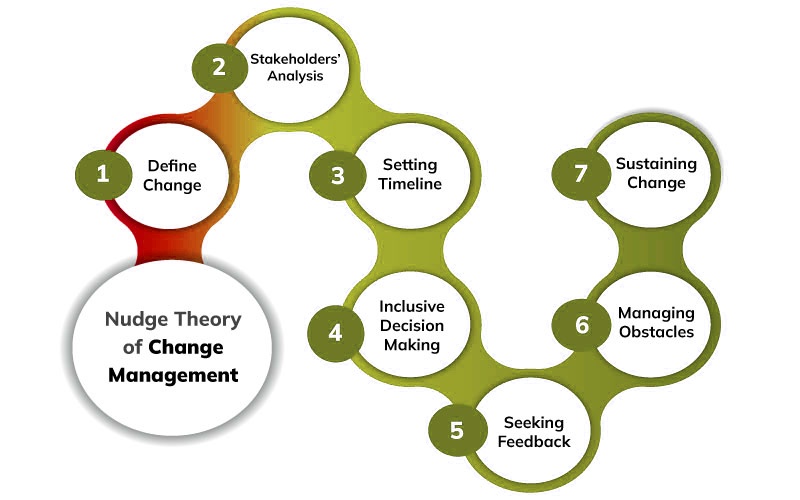Overview
Reflection serves as a powerful tool for individuals across diverse professions and personal contexts to engage in introspection, learn from experiences, and enhance professional and personal growth. Reflection models offer structured frameworks that guide individuals through this process, facilitating deeper understanding, critical analysis, and meaningful application of insights gained.
Table of Contents
- Gibbs Reflection Example in Business: Enhancing Customer Service
- Rolfe Reflection Example in Business: Improving Team Communication
- Self-Reflection Example in Marketing: Enhancing Campaign Effectiveness
- Personal Reflection Example in Lifestyle: Cultivating Work-Life Balance
- Critical Reflection Example on Social Media Marketing: Addressing Ethical Considerations
- Academic Reflection Example of a Student: Embracing Growth Through Academic Challenges
- Johns Reflection Example as an Employee: Improving Communication Skills in the Workplace
- Driscoll Reflection Example on a Player: Enhancing Performance Through Self-Assessment
- Schön Reflection Example on an Artist: Exploring Creativity and Innovation
- NMC Reflection Example on an Entrepreneur: Navigating Ethical Dilemmas in Business
- Placement Reflection Example on a Business Owner: Gaining Insights into Entrepreneurship
- Medication Reflection Example: Enhancing Patient Safety Through Medication Management
- Business Reflection Example: Improving Customer Service Through Feedback Analysis
- Era Reflection Example: Navigating Digital Transformation in the Information Age
- Physiotherapy Reflection Example: Enhancing Patient Care Through Reflective Practice
- Dissertation Reflection Example: Navigating the Research Journey
- Leadership Reflection Example: Leading Through Adversity
Practical Applications through Detailed Examples
To illustrate the practical application of reflection models, we will explore detailed examples across various domains, including healthcare, business, education, and personal development. These examples will highlight how reflection models such as Gibbs Reflective Cycle, Rolfe Reflection, and Johns' Model of Reflection can be effectively utilized to analyze experiences, derive meaningful insights, and inform future actions.
Through this comprehensive overview, readers will gain a deeper understanding of reflection models, their significance in professional and personal development, and how they can be applied to enhance learning, improve practice, and foster continuous growth and improvement.
Gibbs Reflection Example in Business: Enhancing Customer Service
Imagine you work as a customer service manager in a retail company that recently introduced a new online platform for purchasing products. The company faced numerous complaints from customers regarding delays in product delivery and difficulties navigating the website.
Stage 1: Description
What Happened?
Customers complained about delays in product delivery and difficulties using the online platform. The company received a significant increase in negative feedback through customer service channels and social media platforms.
Stage 2: Feelings
What Were My Feelings?
Initially, I felt overwhelmed by the influx of complaints and frustrated by the recurring issues with the online platform. There was also a sense of pressure to quickly resolve the issues to maintain customer satisfaction and uphold the company's reputation.
Stage 3: Evaluation
What Was Good and Bad About the Experience?
The negative feedback highlighted areas for improvement in our online platform and customer service processes. However, the continuous stream of complaints also strained the team's morale and created a sense of urgency to address the issues effectively.
Stage 4: Analysis
What Sense Can I Make of the Situation?
Upon reflection, it became evident that the problems stemmed from inadequate testing of the online platform before its launch and insufficient training for customer service representatives to handle inquiries related to the new platform.
Stage 5: Conclusion
What Else Could I Have Done?
In hindsight, I realize that more proactive measures could have been taken to anticipate and mitigate potential issues with the online platform's launch. This includes conducting thorough user testing, providing comprehensive training for staff, and implementing a robust system for monitoring and addressing customer feedback promptly.
Stage 6: Action Plan
What Will I Do Differently in Similar Situations in the Future?
Moving forward, I will advocate for a more rigorous testing and training process before the implementation of any new systems or platforms. Additionally, I will establish clear communication channels for collecting and addressing customer feedback to ensure timely resolution of issues and enhance overall customer satisfaction.
Stage 7: Learning
What Did I Learn from This Experience?
This experience taught me the importance of proactive planning, thorough testing, and effective communication in the implementation of new initiatives in business. It also underscored the significance of continuously evaluating and improving processes to meet customer needs and maintain competitiveness in the market.
By following the Gibbs Reflective Cycle, I have gained valuable insights into the challenges faced in managing customer service in a dynamic business environment. These reflections will inform my future decisions and actions, contributing to the ongoing improvement of customer service practices within the company.
Rolfe Reflection Example in Business: Improving Team Communication
You are a project manager in a technology company leading a cross-functional team responsible for developing a new software product. Despite having skilled team members, you have noticed a lack of effective communication leading to misunderstandings, delays, and decreased productivity.
1. What? - Descriptive Phase:
In the project kickoff meeting, it became evident that there were frequent miscommunications among team members regarding project requirements, timelines, and responsibilities. Despite having regular status meetings, important updates were often overlooked, leading to confusion and delays in project milestones.
2. So What? - Personal Insights:
As the project manager, I felt frustrated and overwhelmed by the breakdown in communication within the team. There was a sense of responsibility to address these issues promptly to ensure the successful delivery of the project within the specified timeline and budget.
3. Now What? - Action-Oriented Insights:
Upon reflection, I realized that the lack of effective communication stemmed from various factors, including ambiguous project goals, insufficient clarity in roles and responsibilities, and inadequate communication channels. Addressing these issues required a proactive approach to facilitate open and transparent communication within the team.
4. What? - Re-evaluation and Analysis:
In re-evaluating the situation, I recognized the importance of establishing clear communication protocols, such as regular status updates, project documentation, and designated channels for addressing concerns and clarifying expectations. Additionally, fostering a culture of open communication and collaboration was essential to mitigate misunderstandings and promote teamwork.
5. So What? - Personal Insights:
Moving forward, I committed to taking proactive steps to improve communication within the team, including organizing regular team meetings to discuss project progress, clarifying roles and responsibilities, and implementing communication tools to streamline information sharing and collaboration.
6. Now What? - Action Plan:
To address the communication challenges effectively, I developed an action plan that included the following steps:
- Conducting a team meeting to clarify project goals, roles, and expectations.
- Establishing a communication schedule for regular status updates and progress reports.
- Implementing collaboration tools, such as project management software and instant messaging platforms, to facilitate real-time communication and document sharing.
- Encouraging open dialogue and feedback sessions to address concerns and resolve conflicts proactively.
7. What? - Learning and Future Insights:
Through this reflective process, I learned the importance of proactive communication in driving project success. By addressing communication challenges early on and implementing effective strategies to promote collaboration and transparency, I was able to improve team dynamics, enhance productivity, and ultimately, deliver the project successfully.
This Rolfe Reflection example highlights the significance of self-awareness, proactive problem-solving, and continuous improvement in addressing communication challenges within a business setting. By leveraging reflective practices, individuals can gain valuable insights, develop action-oriented strategies, and drive positive change within their teams and organizations.
Self-Reflection Example in Marketing: Enhancing Campaign Effectiveness
As a marketing coordinator for a consumer goods company, you were tasked with developing and executing a promotional campaign for a new product launch. Despite thorough planning and implementation, the campaign did not yield the expected results, with lower than anticipated sales and limited customer engagement.
1. Self-Awareness:
Upon reflecting on the marketing campaign, I recognized feelings of disappointment and frustration regarding its outcomes. Despite investing significant time and effort into planning and execution, the results fell short of expectations, leading to self-doubt and a desire to understand the underlying factors contributing to its lack of success.
2. Understanding the Situation:
Through introspection, I identified several potential factors that may have contributed to the campaign's underperformance. This included inadequate market research leading to a misunderstanding of customer preferences, ineffective messaging that failed to resonate with the target audience, and suboptimal distribution channels limiting the product's visibility and accessibility.
3. Identifying Strengths and Weaknesses:
In evaluating my role in the campaign, I recognized both strengths and weaknesses in my approach. While I demonstrated creativity and initiative in developing promotional materials and coordinating campaign logistics, there were areas where I could have improved, such as conducting more comprehensive market research, refining messaging to better align with customer needs, and collaborating more closely with cross-functional teams to optimize campaign execution.
4. Analyzing Lessons Learned:
The experience provided valuable insights into the complexities of marketing strategy and execution. It underscored the importance of conducting thorough market research to understand customer preferences and competitive dynamics, crafting compelling messaging that resonates with the target audience, and leveraging an integrated approach to campaign planning and execution to maximize effectiveness and ROI.
5. Setting Goals for Improvement:
Moving forward, I am committed to applying the lessons learned from this experience to enhance my marketing skills and improve campaign outcomes. This includes:
- Investing more time and resources into market research to gain a deeper understanding of customer preferences and market trends.
- Refining messaging to communicate the product's unique value proposition and benefits more effectively to the target audience.
- Strengthening collaboration and communication with cross-functional teams to ensure alignment and coordination throughout the campaign lifecycle.
6. Taking Action:
To address the shortcomings identified in the reflection process, I have developed an action plan outlining specific steps to improve my marketing capabilities and enhance future campaign effectiveness. This includes enrolling in relevant courses or training programs to further develop skills in market research, messaging development, and cross-functional collaboration, as well as seeking mentorship or guidance from experienced marketing professionals to gain insights and perspectives on best practices in the industry.
7. Reflection on Progress:
By regularly reflecting on my progress and revisiting the lessons learned from past experiences, I aim to continually refine my marketing skills and strategies, driving improved campaign outcomes and contributing to the overall success of the organization's marketing initiatives.
This self-reflection example demonstrates the importance of introspection and self-awareness in identifying areas for improvement and driving personal and professional growth within the field of marketing. By embracing a reflective mindset and taking proactive steps to address weaknesses and capitalize on strengths, individuals can enhance their effectiveness as marketers and achieve greater success in their endeavors.
Personal Reflection Example in Lifestyle: Cultivating Work-Life Balance
As a young professional working in a demanding corporate environment, you find yourself increasingly overwhelmed by the pressures of work, often sacrificing personal time and well-being in pursuit of career success. Despite achieving notable milestones in your professional life, you recognize a growing sense of imbalance and dissatisfaction in your overall lifestyle.
1. Recognizing Feelings and Emotions:
Upon introspection, I acknowledge feelings of stress, fatigue, and discontentment stemming from the relentless pursuit of career goals at the expense of personal fulfillment and well-being. Despite achieving success in my professional endeavors, I realize that I have neglected important aspects of my life, such as family, hobbies, and self-care, leading to a sense of emptiness and burnout.
2. Understanding Priorities and Values:
Through reflection, I realize the need to reassess my priorities and values to align with a more balanced and fulfilling lifestyle. While career advancement is important, I recognize that true happiness and fulfillment stem from nurturing meaningful relationships, pursuing passions and interests, and prioritizing self-care and well-being.
3. Evaluating Lifestyle Choices:
In evaluating my lifestyle choices, I acknowledge patterns of behavior that have contributed to the imbalance between work and personal life. This includes overcommitting to work projects, neglecting leisure activities and social connections, and failing to establish boundaries between work and personal time, leading to chronic stress and dissatisfaction.
4. Identifying Areas for Improvement:
The reflection process highlights several areas for improvement in my lifestyle, including:
- Establishing boundaries: Setting clear boundaries between work and personal life to prioritize self-care, leisure activities, and quality time with loved ones.
- Practicing mindfulness: Incorporating mindfulness practices, such as meditation, deep breathing exercises, and journaling, to manage stress, cultivate self-awareness, and promote emotional well-being.
- Pursuing passions: Rediscovering and prioritizing hobbies, interests, and activities that bring joy, fulfillment, and a sense of purpose outside of work.
5. Setting Goals for Change:
In light of these insights, I am committed to making tangible changes to cultivate a more balanced and fulfilling lifestyle. This includes:
- Implementing a structured daily routine that allocates dedicated time for work, leisure, exercise, and relaxation.
- Prioritizing self-care activities, such as regular exercise, healthy eating, and sufficient sleep, to enhance physical and mental well-being.
- Actively seeking opportunities to reconnect with family and friends, nurture relationships, and create meaningful experiences outside of work.
6. Taking Action:
To facilitate these changes, I have developed a personalized action plan outlining specific steps and strategies to achieve greater work-life balance and overall well-being. This includes seeking support from mentors, peers, and professional resources to navigate challenges and sustain positive lifestyle changes over time.
7. Reflection on Progress:
By regularly reflecting on my progress and revisiting my goals and values, I aim to cultivate a more balanced and fulfilling lifestyle that prioritizes personal well-being, meaningful relationships, and holistic happiness. While the journey towards achieving work-life balance may be challenging, I am committed to taking proactive steps to create a lifestyle that aligns with my values and nurtures my overall well-being.
This personal reflection example underscores the importance of self-awareness, prioritization, and intentional action in cultivating a balanced and fulfilling lifestyle. By embracing reflection as a tool for personal growth and transformation, individuals can achieve greater harmony between their professional aspirations and personal well-being, leading to a more fulfilling and meaningful life.
Critical Reflection Example on Social Media Marketing: Addressing Ethical Considerations
As a social media marketer for a fashion brand, you have been tasked with developing and implementing a promotional campaign to increase brand awareness and drive sales. However, as you delve deeper into the campaign strategy, you encounter ethical dilemmas related to data privacy, authenticity, and the potential impact of social media on mental health.
1. Critical Analysis of Data Privacy Concerns:
In examining the campaign strategy, I critically assess the ethical implications of collecting and utilizing consumer data for targeted advertising. While leveraging data-driven insights can enhance campaign effectiveness, there is a fine line between personalized marketing and intrusiveness. I reflect on the importance of respecting consumer privacy rights and ensuring transparency in data collection and usage practices to maintain trust and credibility with the audience.
2. Evaluation of Authenticity and Transparency:
As I review the content planned for the campaign, I interrogate the authenticity and transparency of the brand's messaging. In an era of influencer marketing and sponsored content, there is a risk of misleading or deceptive advertising practices that compromise consumer trust. I reflect on the ethical responsibility of marketers to disclose sponsored partnerships, accurately represent products or services, and foster genuine connections with the audience to avoid eroding brand credibility.
3. Examination of Social Media's Impact on Mental Health:
Delving deeper into the campaign's objectives, I critically consider the potential impact of social media on mental health and well-being. While social media platforms offer powerful tools for brand promotion and engagement, they also contribute to phenomena such as FOMO (fear of missing out), social comparison, and online harassment. I reflect on the ethical imperative to prioritize the well-being of the target audience, advocate for responsible social media usage, and promote positive and inclusive messaging that fosters empowerment and self-esteem.
4. Reflection on Power Dynamics and Influence:
In analyzing the dynamics of social media marketing, I reflect on the unequal power relationships inherent in the platform's algorithms and influencer culture. The pursuit of virality and engagement metrics can incentivize sensationalism, clickbait tactics, and the amplification of harmful or divisive content. I contemplate the ethical responsibility of marketers to use their influence responsibly, challenge harmful norms, and contribute to a more ethical and inclusive online environment.
5. Actionable Insights and Recommendations:
Drawing from critical reflection, I propose several actionable insights and recommendations to guide the development and execution of the campaign:
- Prioritize transparency and consent in data collection and usage practices, adhering to relevant privacy regulations such as GDPR.
- Embrace authenticity and honesty in brand communication, disclosing sponsored content and avoiding misleading or deceptive advertising tactics.
- Foster positive and inclusive messaging that celebrates diversity, promotes body positivity, and supports mental health and well-being.
- Advocate for ethical guidelines and industry standards that prioritize consumer welfare and social responsibility in social media marketing practices.
6. Commitment to Continuous Learning and Improvement:
In conclusion, I commit to ongoing critical reflection and learning in my role as a social media marketer. By interrogating ethical considerations, challenging assumptions, and advocating for responsible practices, I strive to contribute to a more ethical, authentic, and socially responsible approach to social media marketing that prioritizes the well-being and empowerment of individuals and communities.
This critical reflection example highlights the importance of ethical considerations in social media marketing and the role of critical reflection in promoting responsible and socially conscious practices within the industry. By engaging in critical analysis and reflection, marketers can navigate complex ethical dilemmas, advocate for positive change, and contribute to a more ethical and inclusive digital landscape.
Academic Reflection Example of a Student: Embracing Growth Through Academic Challenges
As a second-year university student majoring in Psychology, I encountered several academic challenges during the semester, including adapting to online learning, managing workload demands, and grappling with complex course material. Reflecting on my academic journey, I have gained valuable insights into my learning process, strengths, and areas for improvement.
1. Reflection on Learning Environment:
The transition to online learning presented both opportunities and challenges. While the flexibility of remote learning allowed me to manage my schedule more effectively, I found it challenging to stay focused and engaged in virtual lectures and discussions. Reflecting on this experience, I recognize the importance of establishing a conducive learning environment, minimizing distractions, and actively participating in online activities to maximize learning outcomes.
2. Evaluation of Time Management Skills:
Managing a heavy workload amidst competing priorities tested my time management skills. Balancing coursework, part-time employment, and extracurricular commitments required careful planning and prioritization. Through reflection, I acknowledge the need to refine my time management strategies, including setting realistic goals, breaking tasks into manageable chunks, and utilizing tools such as calendars and to-do lists to stay organized and on track.
3. Analysis of Academic Performance:
Reflecting on my academic performance, I recognize areas of strength and areas for improvement. While I excelled in coursework that aligned with my interests and strengths, I encountered challenges in subjects requiring advanced quantitative analysis and critical thinking skills. This reflection prompts me to seek additional support and resources to strengthen my proficiency in these areas, such as attending tutoring sessions, seeking clarification from professors, and practicing problem-solving exercises regularly.
4. Identification of Learning Strategies:
In reflecting on my learning process, I identify effective strategies that have contributed to my academic success. Active learning techniques, such as summarizing key concepts, engaging in peer discussions, and applying course material to real-world scenarios, have enhanced my understanding and retention of course material. Moving forward, I commit to incorporating these strategies into my study routine consistently to optimize learning outcomes and academic performance.
5. Setting Goals for Academic Growth:
Drawing from my reflections, I establish several goals to guide my academic growth and development:
- Enhance time management skills by implementing a structured study schedule and minimizing procrastination.
- Strengthen proficiency in challenging subjects through targeted practice and seeking additional support from professors and peers.
- Actively engage in course material by participating in class discussions, seeking clarification on challenging concepts, and applying knowledge to practical scenarios.
6. Commitment to Continuous Improvement:
In conclusion, I embrace the academic challenges I have encountered as opportunities for growth and learning. By engaging in critical reflection, setting meaningful goals, and implementing effective strategies, I am confident in my ability to overcome obstacles, maximize my academic potential, and achieve success in my academic pursuits.
This academic reflection example demonstrates the importance of self-awareness, goal-setting, and continuous improvement in navigating academic challenges and fostering academic success. By embracing a reflective mindset, students can identify areas for growth, leverage their strengths, and cultivate effective learning strategies to excel in their academic endeavors.
Johns Reflection Example as an Employee: Improving Communication Skills in the Workplace
As a new employee in a marketing firm, I encountered challenges in effectively communicating with colleagues and supervisors, resulting in misunderstandings, inefficiencies, and reduced productivity. Reflecting on my experiences using Johns' Model of Reflection, I gained insights into my communication style, identified areas for improvement, and developed strategies to enhance my effectiveness in the workplace.
1. Description of the Experience:
In my role as a marketing assistant, I often struggled to convey my ideas and opinions clearly during team meetings and collaborative projects. Despite possessing valuable insights and contributions, I found it challenging to articulate my thoughts effectively, resulting in miscommunication and frustration among team members. This experience highlighted the importance of effective communication skills in fostering collaboration and achieving common goals within the organization.
2. Reflection on Thoughts and Feelings:
Reflecting on my thoughts and feelings during these interactions, I recognized feelings of insecurity and self-doubt regarding my communication abilities. Fear of being misunderstood or judged by colleagues hindered my willingness to speak up and share my perspectives openly, leading to missed opportunities for meaningful contributions and professional growth.
3. Evaluation of the Experience:
In evaluating the experience, I identified several factors contributing to my communication challenges, including lack of confidence, limited assertiveness, and ineffective verbal expression. These barriers not only hindered my ability to convey information effectively but also impeded my professional development and integration within the team.
4. Analysis of the Learning:
Through reflection, I gained valuable insights into the importance of effective communication skills in the workplace and the impact of my communication style on interpersonal relationships and team dynamics. I realized that improving my communication skills is essential not only for fulfilling my job responsibilities but also for building trust, fostering collaboration, and advancing my career aspirations within the organization.
5. Future Action Plan:
Drawing from my reflections, I developed an action plan to enhance my communication skills and address areas for improvement:
- Attend communication workshops or seminars to learn effective communication techniques, such as active listening, assertiveness, and clarity in verbal expression.
- Seek feedback from colleagues and supervisors on my communication style and areas for development, and actively incorporate constructive criticism into my professional practice.
- Practice assertive communication techniques in everyday interactions, such as expressing my opinions confidently, asking clarifying questions, and actively participating in team discussions and brainstorming sessions.
6. Conclusion and Learning Outcome:
In conclusion, Johns' reflection model provided a structured framework for evaluating my communication experiences as an employee and identifying actionable strategies for improvement. By embracing a reflective mindset and committing to continuous learning and development, I am confident in my ability to enhance my communication skills, overcome challenges, and thrive in my role as a valued member of the organization.
This Johns reflection example demonstrates the value of reflective practice in identifying areas for improvement and developing strategies for personal and professional growth as an employee. By engaging in critical self-reflection, individuals can enhance their self-awareness, identify strengths and weaknesses, and take proactive steps to enhance their effectiveness in the workplace.
Driscoll Reflection Example on a Player: Enhancing Performance Through Self-Assessment
As a soccer coach, I have been working with a talented young player who has shown great potential but struggles with consistency and self-confidence on the field. Using Driscoll's model of reflection, I aim to evaluate the player's performance, identify areas for improvement, and develop strategies to support their development and growth.
1. What? - Description:
The player demonstrates exceptional technical skills and athleticism during training sessions but often struggles to translate these abilities into consistent performance during matches. Despite occasional flashes of brilliance, they exhibit hesitancy, lack of assertiveness, and self-doubt on the field, hindering their overall impact and contribution to the team.
2. So What? - Personal Insights:
Reflecting on the player's performance, I recognize the importance of addressing underlying psychological barriers that may be affecting their confidence and performance. As their coach, I feel a sense of responsibility to provide guidance, support, and encouragement to help the player unlock their full potential and thrive on the field.
3. Now What? - Action-Oriented Insights:
To support the player's development, I plan to implement several strategies:
- Conduct individual meetings to discuss the player's strengths, areas for improvement, and goals for development.
- Provide constructive feedback and encouragement to build the player's confidence and self-belief.
- Implement mental skills training exercises, such as visualization, positive self-talk, and goal-setting, to enhance the player's mental toughness and resilience.
4. What? - Re-evaluation and Analysis:
In re-evaluating the player's performance, I monitor their progress and assess the effectiveness of the strategies implemented. I observe improvements in the player's confidence, assertiveness, and performance on the field, as evidenced by their increased involvement in matches, willingness to take risks, and positive contributions to team success.
5. So What? - Personal Insights:
Through this reflection process, I gain insights into the importance of fostering a supportive and empowering environment for player development. By addressing psychological barriers and nurturing confidence and self-belief, coaches can empower players to overcome challenges, maximize their potential, and achieve success on and off the field.
6. Now What? - Action Plan:
Moving forward, I remain committed to supporting the player's development by:
- Continuing to provide personalized feedback, encouragement, and mentorship to nurture the player's confidence and self-belief.
- Collaborating with sports psychologists or mental skills coaches to implement tailored strategies to enhance the player's mental toughness and resilience.
- Creating a positive and inclusive team culture that celebrates individual strengths, fosters growth mindset, and supports each player's journey towards success.
7. What? - Learning and Future Insights:
Through this reflection process, I learn the importance of holistic player development, which encompasses not only technical and tactical skills but also psychological factors such as confidence, resilience, and self-belief. By adopting a proactive and personalized approach to player support and development, coaches can empower athletes to reach their full potential and achieve success in their athletic pursuits.
This Driscoll reflection example illustrates the value of self-assessment and action-oriented insights in supporting player development and performance enhancement. By engaging in reflective practice, coaches can identify areas for improvement, implement targeted strategies, and empower athletes to achieve their goals and aspirations in sports.
Schön Reflection Example on an Artist: Exploring Creativity and Innovation
As a visual artist, I often find myself grappling with creative blocks, self-doubt, and the pressures of producing original and meaningful artwork. Using Schön's model of reflection, I aim to explore my creative process, identify patterns of thinking and behavior, and cultivate a deeper understanding of my artistic practice.
1. Reflection-in-Action:
In the midst of creating a new piece of artwork, I encounter a creative block and struggle to translate my vision onto the canvas. As I experiment with different techniques and approaches, I notice feelings of frustration and self-doubt creeping in, leading to a sense of stagnation and uncertainty about the direction of the artwork.
2. Reflection-on-Action:
Stepping back from the artwork, I reflect on my creative process and the factors contributing to the creative block. I realize that my tendency to overthink and self-criticize inhibits my creative flow, preventing me from fully embracing experimentation and spontaneity in my artistic expression.
3. Identifying Patterns:
Through reflection, I identify patterns of thinking and behavior that hinder my creativity, including fear of failure, perfectionism, and comparison to others. These ingrained patterns of self-limiting beliefs and negative self-talk create barriers to innovation and inhibit my ability to explore new ideas and techniques freely.
4. Experimentation and Exploration:
Armed with insights from reflection, I commit to embracing experimentation and exploration in my artistic practice. I challenge myself to step outside of my comfort zone, take risks, and push the boundaries of traditional artistic conventions to unlock new creative possibilities and perspectives.
5. Reframing Challenges as Opportunities:
Rather than viewing creative blocks as obstacles, I reframe them as opportunities for growth and innovation. I embrace the uncertainty and ambiguity inherent in the creative process, recognizing that moments of struggle and discomfort often precede breakthroughs and artistic discoveries.
6. Cultivating a Reflective Practice:
To support ongoing growth and development as an artist, I prioritize cultivating a reflective practice. I commit to regular self-reflection sessions, journaling, and dialogue with fellow artists to gain insights, share experiences, and deepen my understanding of the creative process.
7. Integration and Application:
Moving forward, I integrate insights gained from reflection into my artistic practice, incorporating elements of spontaneity, curiosity, and playfulness into my work. I approach each new project with a sense of openness and possibility, embracing the journey of exploration and discovery that lies ahead.
Through this Schön reflection example, I recognize the transformative power of reflection in nurturing creativity, fostering innovation, and overcoming obstacles in artistic practice. By engaging in reflective inquiry and embracing a growth mindset, artists can unlock their full creative potential, push the boundaries of their craft, and make meaningful contributions to the world of art and culture
NMC Reflection Example on an Entrepreneur: Navigating Ethical Dilemmas in Business
As an entrepreneur in the technology sector, I often encounter ethical dilemmas related to data privacy, corporate social responsibility, and business integrity. Using the Nursing and Midwifery Council (NMC) model of reflection, I aim to evaluate my decision-making process, identify ethical considerations, and develop strategies to navigate complex ethical challenges in business.
1. Description
Recently, my company faced a dilemma regarding the use of consumer data for targeted advertising. While leveraging data analytics can enhance marketing effectiveness and drive business growth, there are ethical concerns surrounding the collection, storage, and usage of personal information. The decision to utilize consumer data for targeted advertising poses risks to privacy and data security and raises questions about transparency and consent.
2. Feelings
Reflecting on the decision-making process, I acknowledge feelings of uncertainty and moral discomfort. While I recognize the potential benefits of data-driven marketing strategies, I also grapple with concerns about violating consumer trust, compromising privacy rights, and undermining the company's reputation for ethical business practices.
3. Evaluation
In evaluating the ethical dimensions of the decision, I consider the principles of autonomy, beneficence, nonmaleficence, and justice. I recognize the importance of respecting consumer autonomy and privacy rights, ensuring transparency and informed consent in data collection and usage practices, and minimizing potential harm to individuals resulting from data exploitation.
4. Analysis
Through critical analysis, I explore alternative courses of action and their potential ethical implications. I consider options such as implementing stringent data protection measures, obtaining explicit consent from consumers for data usage, and adopting transparent communication practices to inform consumers about data collection and usage practices.
5. Conclusion and Action Plan
In conclusion, I commit to upholding ethical principles in business decision-making and practice. I develop an action plan to:
- Conduct a comprehensive ethical review of data usage policies and practices within the company.
- Implement safeguards to protect consumer privacy and data security, such as encryption, anonymization, and data minimization techniques.
- Foster a culture of ethical leadership and accountability within the organization, emphasizing the importance of integrity, transparency, and social responsibility in all business activities.
6. Learning and Future Insights
Through this reflection process, I gain insights into the complexities of ethical decision-making in business and the importance of ethical leadership in promoting trust, integrity, and sustainability. I recognize the ongoing nature of ethical reflection and commit to continuous learning and improvement in navigating ethical challenges and promoting ethical excellence in business practice.
By applying the NMC model of reflection, I am better equipped to navigate ethical dilemmas in business, uphold ethical standards, and foster a culture of integrity and responsibility within my company. Through critical self-reflection and ethical inquiry, entrepreneurs can contribute to a more ethical, sustainable, and socially responsible business environment.
Placement Reflection Example on a Business Owner: Gaining Insights into Entrepreneurship
During my placement as a business management student, I had the opportunity to work closely with a seasoned entrepreneur who owns a small manufacturing business. Through this experience, I gained valuable insights into the challenges and opportunities of entrepreneurship, as well as the practical skills and knowledge required to succeed in the business world.
1. Observation and Description
During my placement, I observed the day-to-day operations of the business, including production processes, supply chain management, marketing strategies, and financial planning. I witnessed firsthand the dedication, hard work, and resilience required to navigate the complexities of running a successful business in a competitive market.
2. Feelings and Reactions
As I immersed myself in the business environment, I experienced a range of emotions, including excitement, curiosity, and occasional moments of uncertainty. While I was eager to learn and contribute to the company's success, I also felt a sense of pressure to perform and a fear of making mistakes that could impact the business.
3. Evaluation and Analysis
Reflecting on my experiences, I gained insights into the key challenges and opportunities facing entrepreneurs. I learned about the importance of market research, customer engagement, financial management, and strategic planning in driving business growth and sustainability. I also gained an appreciation for the entrepreneurial mindset, characterized by innovation, adaptability, and a willingness to take calculated risks.
4. Learning and Growth
Through my placement experience, I acquired practical skills and knowledge that complemented my academic studies. I learned how to apply theoretical concepts in real-world scenarios, analyze business operations, identify areas for improvement, and develop strategic recommendations to enhance business performance. Additionally, I gained confidence in my abilities as a future business leader and entrepreneur.
5. Action Plan and Future Goals
Moving forward, I plan to leverage the insights and skills gained from my placement experience to pursue my career aspirations in business management and entrepreneurship. I aim to continue learning and growing in the field, seeking opportunities to further develop my expertise, expand my professional network, and contribute to the success of businesses in various industries.
6. Conclusion and Reflection
In conclusion, my placement experience provided a valuable opportunity to gain practical experience, insights, and skills in entrepreneurship. Through reflection, I gained a deeper understanding of the challenges and opportunities facing business owners and entrepreneurs, as well as the personal and professional growth that comes from stepping outside of my comfort zone and embracing new experiences.
This placement reflection example highlights the transformative power of experiential learning in preparing students for careers in business management and entrepreneurship. By immersing themselves in real-world business environments, students can gain valuable insights, develop practical skills, and cultivate the mindset and resilience required to succeed in the dynamic and competitive business world.
Medication Reflection Example: Enhancing Patient Safety Through Medication Management
As a nurse working in a busy hospital setting, I recently encountered a medication error incident that prompted me to reflect on the importance of medication safety and the need for vigilance in medication management practices.
1. Description of the Incident
During a busy shift, I administered a medication to a patient without double-checking the dosage against the physician's orders. It was only after administering the medication that I realized I had inadvertently administered the wrong dosage, putting the patient at risk of adverse effects and potential harm.
2. Feelings and Reactions
Upon realizing the medication error, I experienced a range of emotions, including shock, guilt, and concern for the patient's well-being. I felt responsible for the error and worried about the potential consequences for the patient's health. Additionally, I felt frustrated with myself for not adhering to proper medication administration protocols and procedures.
3. Evaluation and Analysis
Reflecting on the incident, I identified several factors that contributed to the medication error, including workload pressures, distractions, and lapses in attention to detail. I realized that in the fast-paced environment of the hospital, it is easy to become overwhelmed and lose focus, leading to errors in medication administration.
4. Learning and Insights
Through this reflection process, I gained valuable insights into the importance of medication safety and the critical role that nurses play in preventing medication errors. I learned the importance of adhering to established medication administration protocols, including double-checking medication orders, verifying dosages, and maintaining a high level of vigilance during the medication administration process.
5. Action Plan and Future Goals
Moving forward, I am committed to implementing several strategies to enhance medication safety and prevent future errors:
- Prioritize patient safety by taking the time to double-check medication orders and verify dosages before administering medications.
- Advocate for a supportive work environment that encourages open communication, teamwork, and collaboration to prevent medication errors and promote a culture of safety.
- Seek additional training and education on medication administration best practices, including error prevention strategies and techniques for improving medication safety.
6. Conclusion and Reflection
In conclusion, the medication error incident served as a wake-up call for the importance of medication safety in nursing practice. Through reflection, I gained a deeper understanding of the factors contributing to medication errors and the need for ongoing vigilance and adherence to best practices in medication management. By embracing a culture of safety and continuous improvement, I am confident in my ability to prevent future errors and ensure the well-being of my patients.
This medication reflection example highlights the importance of reflection in nursing practice and the critical role that nurses play in promoting medication safety and preventing errors. By reflecting on past experiences and learning from mistakes, nurses can enhance their clinical practice, improve patient outcomes, and contribute to a culture of safety in healthcare settings.
Business Reflection Example: Improving Customer Service Through Feedback Analysis
As the manager of a retail business, I recently received feedback from several customers expressing dissatisfaction with the level of customer service provided by our staff. Recognizing the importance of addressing these concerns to maintain customer satisfaction and loyalty, I initiated a process of reflection to identify areas for improvement and develop strategies to enhance the customer service experience.
1. Analysis of Customer Feedback
Upon reviewing the feedback received from customers, I identified common themes and concerns, including:
- Long wait times at checkout counters.
- Inattentive or unfriendly staff interactions.
- Difficulty in finding products or receiving assistance from staff members.
- Lack of responsiveness to customer inquiries or complaints.
2. Evaluation of Current Practices
Reflecting on the feedback, I evaluated our current customer service practices and identified areas where improvements could be made. I recognized that while our staff members were knowledgeable about products, they lacked training in interpersonal skills and were often overwhelmed during busy periods, leading to subpar customer experiences.
3. Identification of Areas for Improvement
Based on my analysis, I identified several areas for improvement in our customer service practices:
- Implementing additional training programs for staff members to enhance communication and interpersonal skills.
- Streamlining checkout processes to reduce wait times and improve efficiency.
- Enhancing staff responsiveness to customer inquiries and complaints through improved communication channels and protocols.
- Conducting regular assessments and evaluations of customer service performance to identify areas for further improvement.
4. Action Plan for Improvement
To address these concerns, I developed an action plan that included the following steps:
- Implementing a comprehensive training program for all staff members focused on enhancing communication skills, empathy, and problem-solving abilities.
- Introducing new technology solutions, such as self-checkout kiosks or mobile payment options, to expedite the checkout process and reduce wait times.
- Establishing a customer feedback mechanism, such as online surveys or suggestion boxes, to gather continuous feedback and monitor customer satisfaction levels.
- Designating a customer service representative or team responsible for addressing customer inquiries, complaints, and feedback in a timely and efficient manner.
5. Monitoring and Evaluation
To ensure the effectiveness of these initiatives, I committed to monitoring customer feedback, staff performance, and key performance indicators related to customer service. Regular evaluations and assessments would allow us to identify areas of success and areas requiring further improvement, enabling us to refine our strategies and practices over time.
6. Reflection on Progress
Through this process of reflection and action, I gained valuable insights into the importance of listening to customer feedback and continuously striving to improve the customer service experience. By addressing concerns proactively and implementing solutions that align with customer needs and preferences, I am confident that we can enhance customer satisfaction, loyalty, and ultimately, the success of our business.
This business reflection example illustrates the importance of reflection in identifying areas for improvement and developing strategies to enhance customer service in a retail setting. By listening to customer feedback, evaluating current practices, and taking proactive steps to address concerns, businesses can improve customer satisfaction and loyalty, driving long-term success and profitability.
Era Reflection Example: Navigating Digital Transformation in the Information Age
As a business owner operating in the era of digital transformation, I have witnessed profound changes in consumer behavior, technological advancements, and market dynamics. Reflecting on the impact of this era on my business, I have gained valuable insights into the opportunities and challenges presented by the Information Age.
1. Evolution of Consumer Behavior
In the Information Age, consumer behavior has undergone a significant transformation, driven by advancements in technology and the widespread adoption of digital devices and platforms. Reflecting on this evolution, I have observed a shift towards online shopping, personalized experiences, and instant access to information, challenging traditional business models and necessitating adaptation to meet evolving consumer expectations.
2. Technological Advancements
The rapid pace of technological innovation has revolutionized the way businesses operate, communicate, and deliver value to customers. From artificial intelligence and machine learning to data analytics and automation, emerging technologies offer unprecedented opportunities for efficiency, personalization, and growth. Reflecting on these advancements, I have embraced digital tools and platforms to streamline operations, enhance customer engagement, and drive innovation within my business.
3. Market Dynamics and Competition
In the Information Age, the business landscape has become increasingly competitive and dynamic, characterized by disruptive startups, agile competitors, and shifting market trends. Reflecting on this environment, I have recognized the importance of agility, adaptability, and continuous innovation in maintaining a competitive edge and sustaining long-term success in the marketplace.
4. Challenges and Opportunities
While the Information Age presents numerous opportunities for growth and innovation, it also poses significant challenges for businesses, including cybersecurity threats, data privacy concerns, and digital disruption. Reflecting on these challenges, I have prioritized investments in cybersecurity measures, data protection protocols, and digital literacy training to mitigate risks and capitalize on opportunities in the digital economy.
5. Adaptation and Resilience
Through reflection, I have come to appreciate the importance of adaptation and resilience in navigating the complexities of the Information Age. By embracing change, fostering a culture of innovation, and staying attuned to emerging trends and technologies, I have positioned my business to thrive in an ever-evolving landscape, poised to seize new opportunities and overcome obstacles as they arise.
6. Collaboration and Partnerships
In navigating the Information Age, I have recognized the value of collaboration and strategic partnerships in driving innovation and growth. Reflecting on this insight, I have sought opportunities to collaborate with technology partners, industry experts, and other stakeholders to leverage complementary strengths, share resources, and co-create value in an increasingly interconnected and interdependent ecosystem.
7. Conclusion and Future Outlook
In conclusion, the Information Age has brought about profound changes in the way businesses operate, communicate, and compete in the global marketplace. Through reflection, I have gained valuable insights into the opportunities and challenges presented by this era and have embraced a mindset of adaptation, innovation, and collaboration to navigate the complexities of the digital landscape and drive sustainable growth and success in the years to come.
This era reflection example highlights the transformative impact of the Information Age on businesses and the importance of reflection in navigating the challenges and opportunities presented by technological advancements, evolving consumer behavior, and dynamic market dynamics. By reflecting on past experiences and insights, businesses can adapt, innovate, and thrive in an increasingly digital and interconnected world.
Physiotherapy Reflection Example: Enhancing Patient Care Through Reflective Practice
As a physiotherapist working in a rehabilitation clinic, I recently encountered a challenging case involving a patient recovering from a severe knee injury. Reflecting on this experience, I gained valuable insights into the complexities of patient care, the importance of multidisciplinary collaboration, and the role of reflective practice in improving clinical outcomes.
1. Patient Case Description
The patient, a middle-aged athlete, presented with a complex knee injury resulting from a sports-related accident. Their recovery journey was fraught with setbacks, including persistent pain, limited range of motion, and difficulty performing activities of daily living. Despite intensive physiotherapy interventions, progress was slow, and the patient expressed frustration and discouragement about their prognosis.
2. Feelings and Reactions
As I worked with the patient, I experienced a range of emotions, including empathy, compassion, and occasional frustration. Witnessing the patient's struggles and setbacks weighed heavily on me, and I felt a sense of responsibility to provide effective care and support to help them achieve their rehabilitation goals.
3. Evaluation of Treatment Strategies
Reflecting on the patient's case, I evaluated the effectiveness of our treatment strategies and interventions. While we employed evidence-based techniques such as manual therapy, exercise prescription, and modalities to address pain and improve mobility, progress was slower than anticipated, highlighting the complexity and multifactorial nature of the patient's condition.
4. Identification of Learning Points
Through reflection, I identified several learning points and areas for improvement in my approach to patient care:
- Recognizing the importance of individualized treatment plans tailored to the unique needs and goals of each patient.
- Emphasizing patient education and empowerment to foster active participation in their rehabilitation journey and promote self-management strategies.
- Leveraging multidisciplinary collaboration with other healthcare professionals, such as orthopedic surgeons, pain specialists, and psychologists, to optimize patient outcomes and holistic care delivery.
5. Action Plan for Improvement
To address these insights, I developed an action plan to enhance my clinical practice:
- Engage in regular peer supervision and case discussions with colleagues to gain insights, share experiences, and refine treatment approaches.
- Attend continuing education courses and workshops to stay updated on the latest evidence-based practices and techniques in physiotherapy.
- Foster open communication and collaboration with other members of the healthcare team to ensure coordinated and comprehensive care for patients with complex rehabilitation needs.
6. Reflection on Growth and Development
Through this reflective process, I gained a deeper appreciation for the complexities of patient care and the importance of continuous learning and improvement in the field of physiotherapy. By embracing a reflective practice, I am better equipped to navigate challenging cases, optimize treatment outcomes, and provide compassionate and effective care to patients in need.
This physiotherapy reflection example illustrates the value of reflective practice in improving clinical outcomes, enhancing patient care, and fostering professional growth and development in the field of physiotherapy. By engaging in critical self-reflection and action-oriented learning, physiotherapists can optimize their clinical practice, address challenges, and deliver high-quality care to patients with diverse rehabilitation needs.
Dissertation Reflection Example: Navigating the Research Journey
For my dissertation, I investigated the impact of mindfulness-based interventions on stress reduction among college students. This research project involved conducting a literature review, designing a research methodology, collecting and analyzing data, and drawing conclusions based on the findings.
1. Initial Research Process
At the beginning of my dissertation journey, I conducted an extensive literature review to explore existing research on mindfulness interventions and stress management. This process helped me refine my research questions, identify gaps in the literature, and develop a theoretical framework for my study.
2. Methodological Challenges
Designing the research methodology posed several challenges, particularly in selecting appropriate measures of stress and mindfulness and determining the most suitable research design. I struggled to balance the need for scientific rigor with the practical constraints of conducting research in a college setting.
3. Data Collection and Analysis
Collecting data from college students proved to be a time-consuming and labor-intensive process. Despite encountering difficulties in recruitment and data collection, I persevered and ultimately gathered a sufficient sample size to conduct meaningful analysis. However, I faced challenges in data analysis, particularly in interpreting qualitative responses and applying statistical techniques.
4. Reflection on Findings
Upon analyzing the data, I found mixed results regarding the effectiveness of mindfulness interventions in reducing stress among college students. While quantitative analysis indicated a significant reduction in self-reported stress levels post-intervention, qualitative findings revealed individual differences in the perceived benefits of mindfulness practices.
5. Discussion and Interpretation
In the discussion section of my dissertation, I critically examined the implications of my findings, considering factors such as the duration and intensity of mindfulness interventions, participant characteristics, and contextual influences on stress reduction outcomes. I also reflected on limitations of the study and avenues for future research in this area.
6. Personal and Academic Growth
Throughout the dissertation process, I experienced moments of frustration, self-doubt, and uncertainty. However, these challenges provided opportunities for personal and academic growth. I developed resilience, problem-solving skills, and a deeper appreciation for the research process, despite its inherent complexities and uncertainties.
7. Conclusion and Future Directions
In conclusion, my dissertation journey was a transformative experience that enabled me to deepen my understanding of mindfulness, stress management, and research methodology. While the journey was challenging, it was also immensely rewarding, as it allowed me to contribute to the body of knowledge in my field and develop valuable skills that will serve me well in my future academic and professional endeavors.
This dissertation reflection example highlights the iterative nature of the research process and the personal and academic growth that occurs through engaging in scholarly inquiry. By reflecting on the challenges, successes, and insights gained throughout the dissertation journey, researchers can deepen their understanding of their topic of study, refine their research skills, and contribute meaningfully to their field of inquiry.
Leadership Reflection Example: Leading Through Adversity
As a team leader in a technology company, I encountered a significant challenge when our project faced unexpected setbacks, threatening to derail our timeline and jeopardize our deliverables. Reflecting on this experience, I gained insights into effective leadership strategies for navigating adversity, fostering resilience, and driving team success.
1. Initial Response to Adversity
When confronted with the unexpected setbacks, I initially felt a sense of overwhelm and uncertainty about how to proceed. However, I recognized the importance of remaining calm and composed in the face of adversity to inspire confidence and stability among team members.
2. Communication and Transparency
To address the challenges, I prioritized open and transparent communication with team members, stakeholders, and project sponsors. I provided regular updates on the situation, acknowledged the setbacks, and solicited input and feedback from the team to collaboratively develop solutions.
3. Empowering Team Members
Recognizing the expertise and capabilities of my team members, I empowered them to take ownership of their areas of responsibility and contribute their insights and expertise to problem-solving efforts. I encouraged creativity, innovation, and collaboration to generate solutions and overcome obstacles.
4. Resilience and Adaptability
As a leader, I embraced a mindset of resilience and adaptability, recognizing that setbacks are inevitable in complex projects. Instead of dwelling on the challenges, I focused on identifying lessons learned, adapting our approach, and mobilizing resources to address obstacles and move forward.
5. Leading by Example
To inspire resilience and determination among team members, I led by example, demonstrating perseverance, optimism, and a proactive approach to problem-solving. I remained accessible and approachable, offering support, guidance, and encouragement to team members as they navigated challenges.
6. Reflection on Leadership Effectiveness
Reflecting on my leadership approach during this challenging period, I recognized both strengths and areas for improvement. While I effectively fostered open communication, empowered team members, and demonstrated resilience, I also identified opportunities to further develop my skills in conflict resolution, decision-making under pressure, and strategic planning.
7. Learning and Growth
Through this leadership reflection, I gained valuable insights into effective leadership strategies for navigating adversity and driving team success. I learned the importance of communication, empowerment, resilience, and leading by example in fostering a positive and productive team culture.
8. Future Leadership Development
Moving forward, I am committed to ongoing leadership development and growth. I plan to seek feedback from team members and colleagues, engage in leadership training and development opportunities, and continue reflecting on my experiences to refine my leadership skills and enhance my effectiveness as a leader.
This leadership reflection example demonstrates the importance of self-awareness, communication, empowerment, and resilience in effective leadership. By reflecting on their experiences, leaders can gain valuable insights, identify areas for growth, and develop strategies to inspire and empower their teams to overcome challenges and achieve success.


